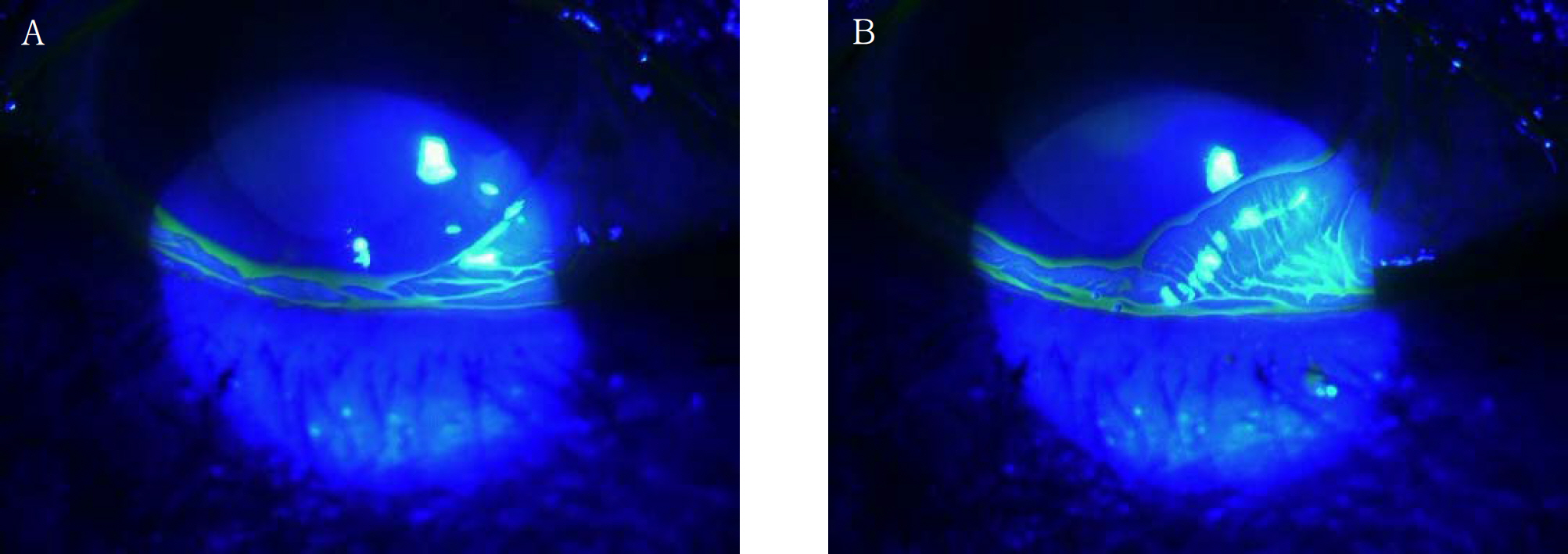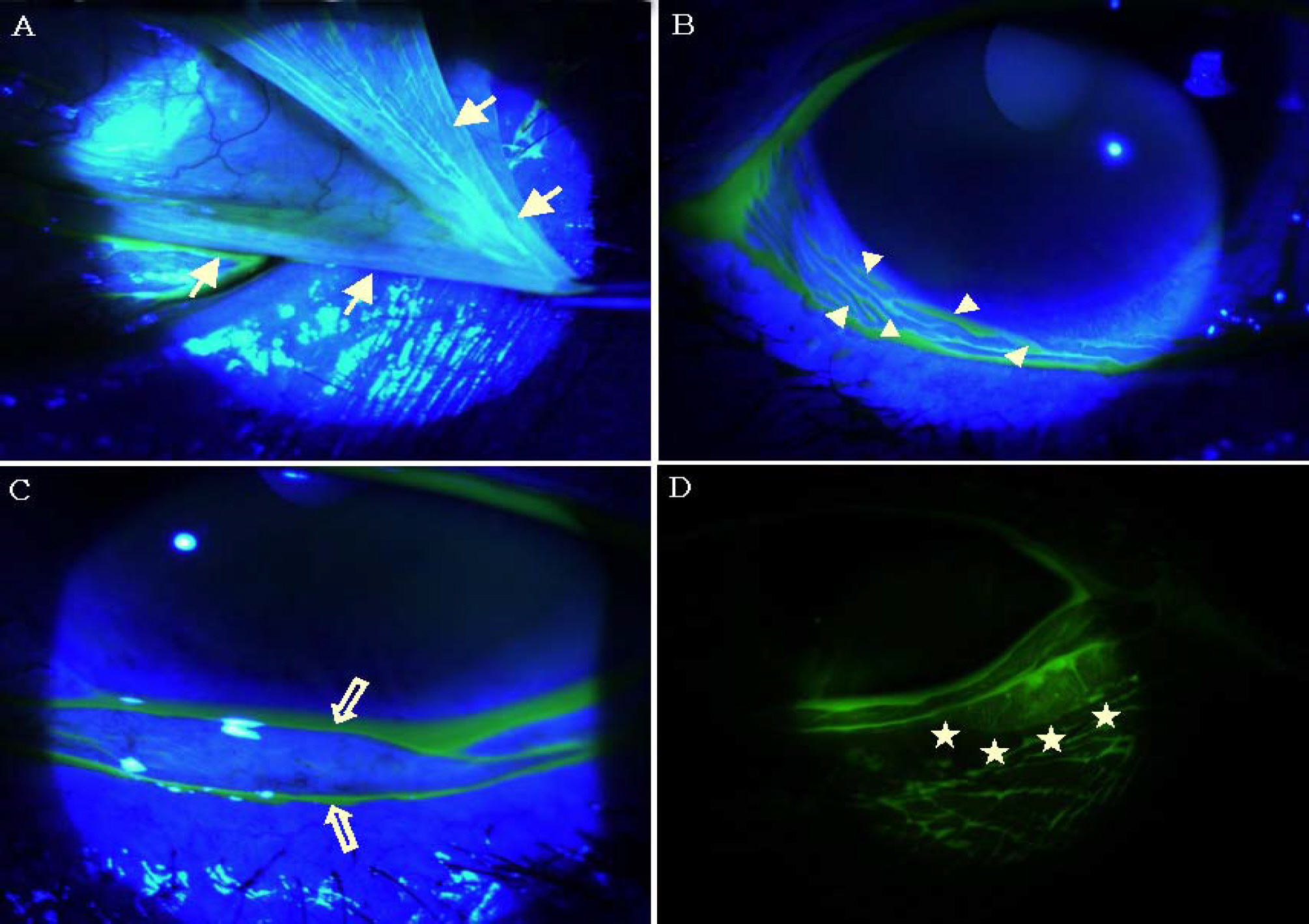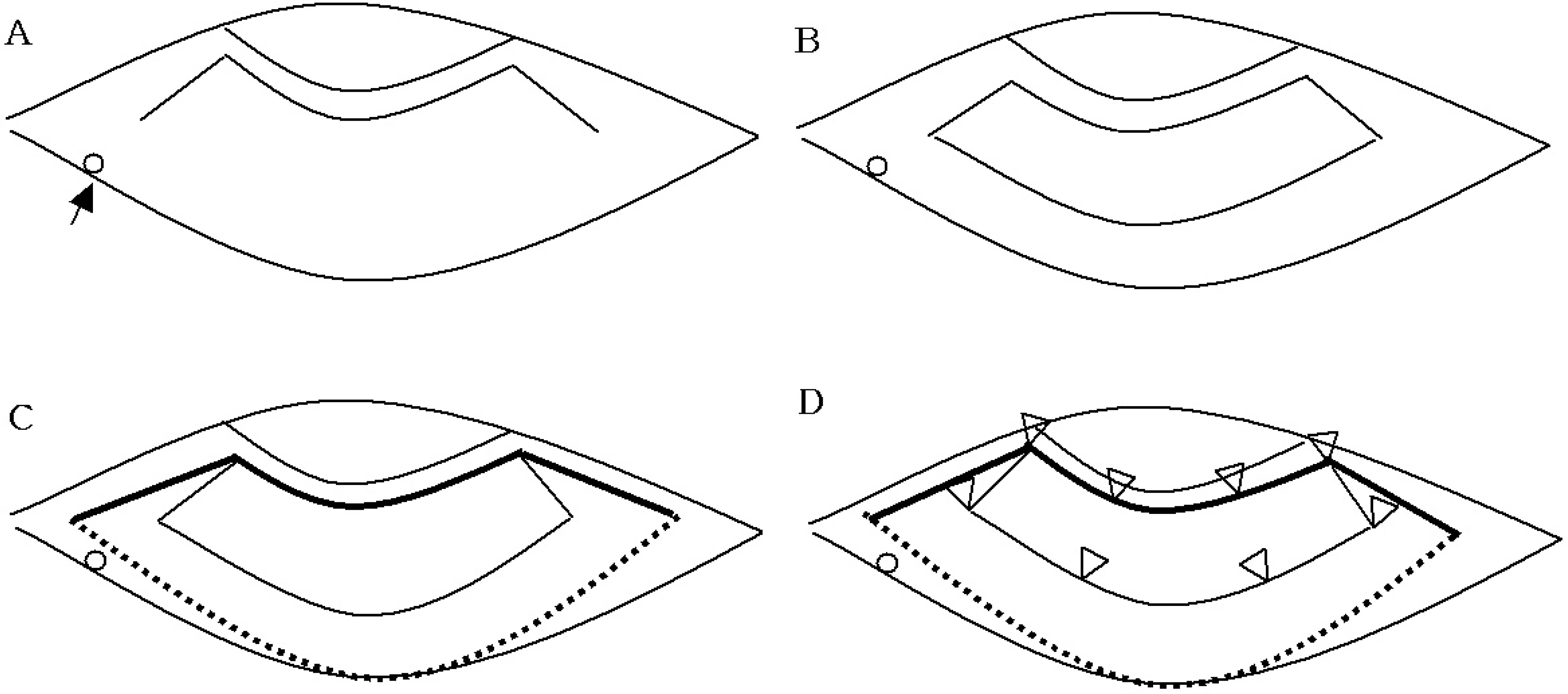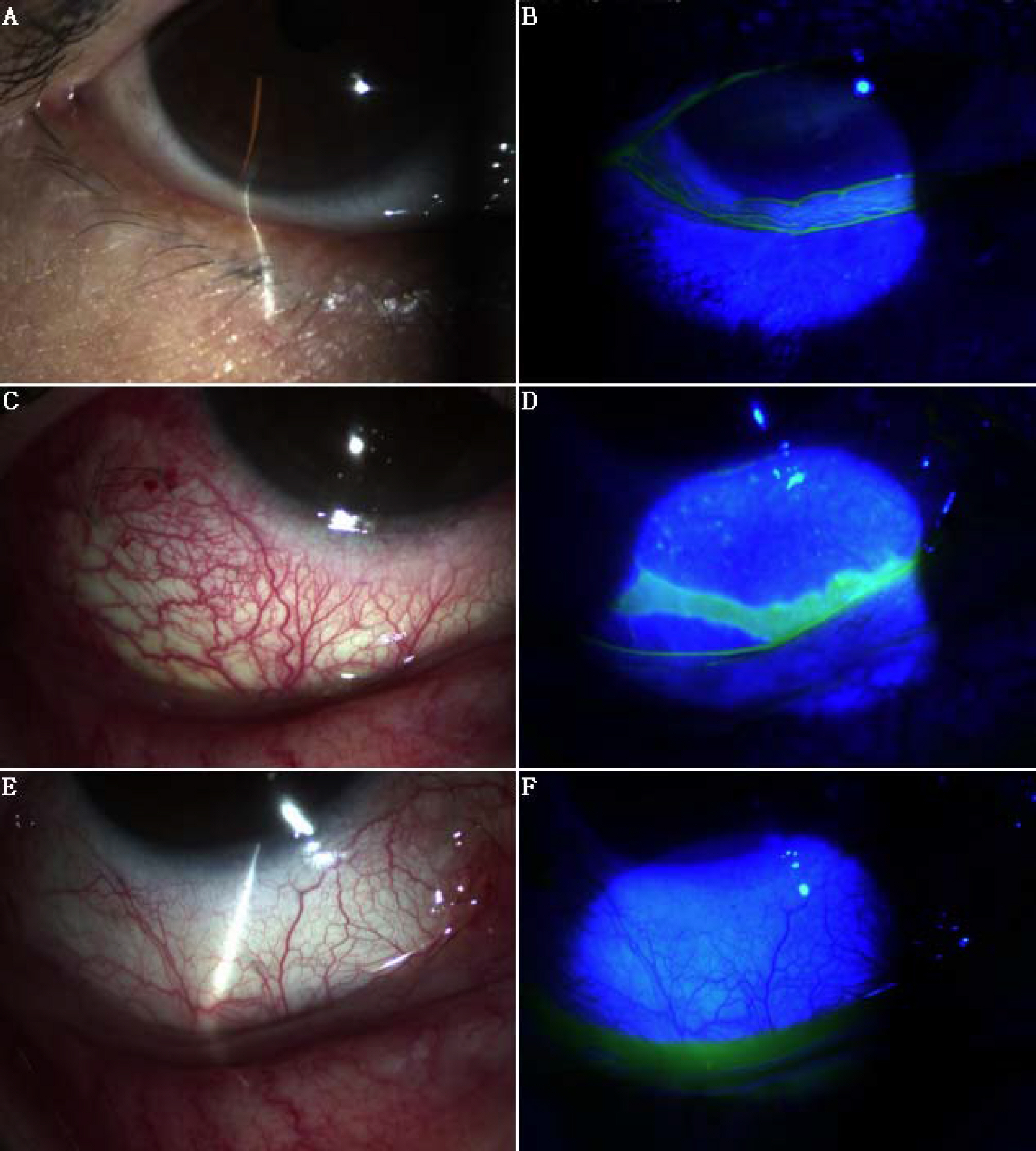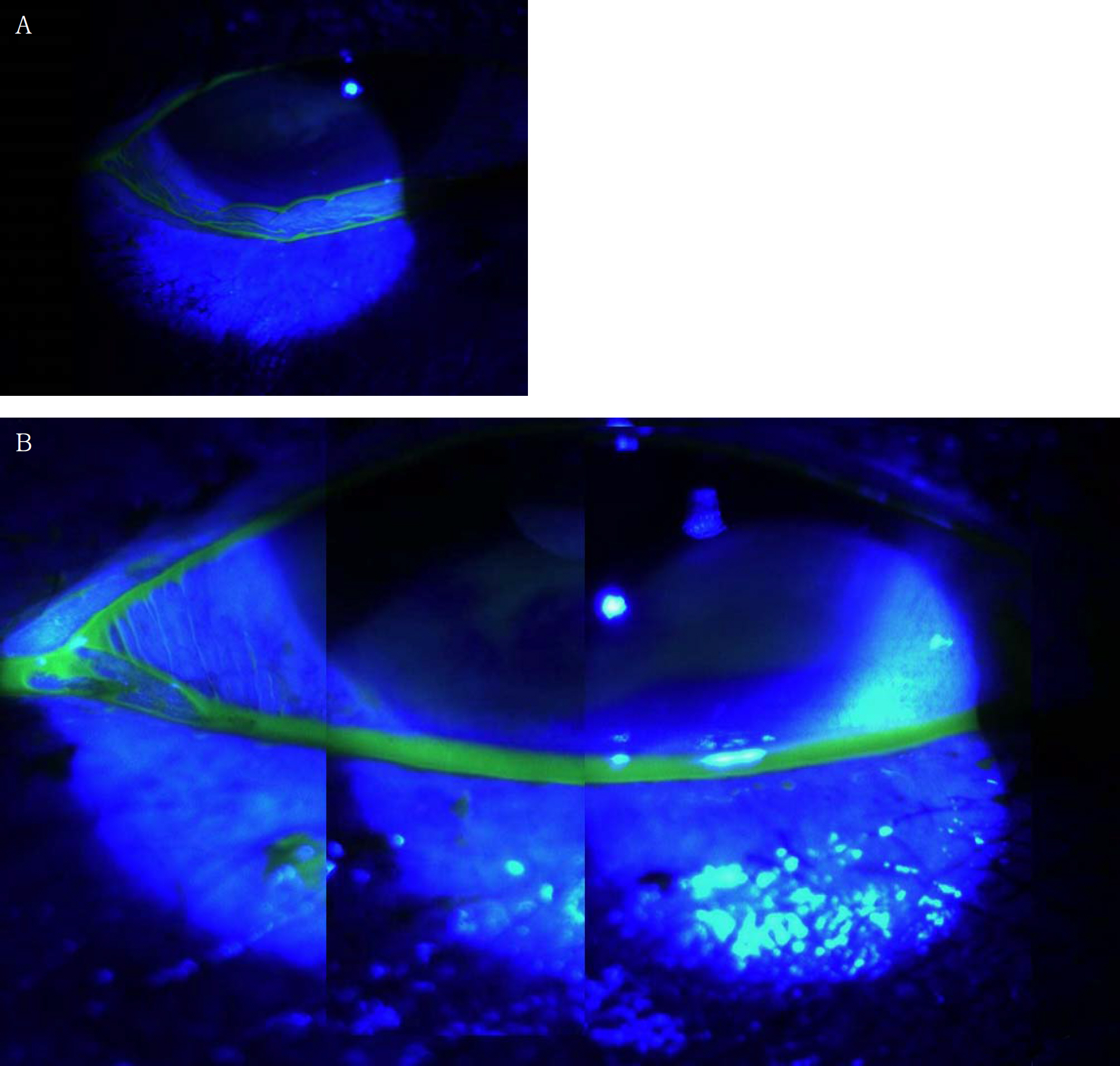Conjunctivochalasis Surgery: Amniotic Membrane Transplantation with Fibrin Glue
- Affiliations
-
- 1Department of Ophthalmology, Daegu Fatima Hospital, Daegu, Korea. djoph2540@yahoo.co.kr
- KMID: 2127109
- DOI: http://doi.org/10.3341/jkos.2008.49.2.195
Abstract
-
PURPOSE: We evaluated the effect of amniotic membrane transplantation with fibrin glue after redundant conjunctival resection.
METHODS
After enchelon-shaped resection of inferior redundant conjunctiva, an amniotic membrane was transplanted using fibrin glue in symptomatic conjunctivochalasis. Conjunctiva was fixed to the episclera with 10-0 nylon.
RESULTS
The subjects were 18 eyes of 9 patients (two males=4 eyes, seven females=14 eyes) with an average age of 67.9+/-7.7 years (range: 54-79 years). Mean operation time was 35.6+/-5.6 minutes/eye (range: 30-45 minutes/eye) and mean numbers of sutures were 8+/-0.76 (range: 7-9). The mean follow-up period was 10.4+/-3 months (range: 6-14 months) and the mean time to full epithelization was 14.5+/-3.4 days (range: 11-20 days). At postoperative days 1-2, the lower tear meniscus was reconstructed. There were no recurrences or any postoperative complications observed.
CONCLUSIONS
Amniotic membrane transplantation after redundant conjunctival resection in conjunctivochalasis resulted in reconstruction of the lower tear meniscus with stable conjunctival surface and marked improvement of subjective symptoms. Operation time and early postoperative irritation symptoms could be reduced with the use of fibrin glue.
MeSH Terms
Figure
Cited by 4 articles
-
Histopathologic Characteristics of Conjunctivochalasis
Jeong Bum Bae, Woo Chan Park
J Korean Ophthalmol Soc. 2013;54(8):1165-1174. doi: 10.3341/jkos.2013.54.8.1165.The Effects of Conjunctival Shield on Pain Alleviation During Cataract Surgery in Conjunctivochalasis Patients
Hae Won Seo, Suk Kyue Choi, Do Hyung Lee, Jin Hyoung Kim
J Korean Ophthalmol Soc. 2013;54(1):60-64. doi: 10.3341/jkos.2013.54.1.60.Changes in Area of Conjunctiva and Tear Meniscus Measured Using Anterior Segment Optical Coherence Tomography after Conjunctivochalasis Surgery
Jong Soo Kim, Jeong Bum Bae, Jang Won Seo, Woo Chan Park
J Korean Ophthalmol Soc. 2015;56(4):509-514. doi: 10.3341/jkos.2015.56.4.509.The Efficacy of Fibrin Glue in Surgical Treatment of Conjunctivochalasis With Epiphora
Kiyup Nam, Young Joon Jo, Sung Bok Lee
J Korean Ophthalmol Soc. 2010;51(4):498-503. doi: 10.3341/jkos.2010.51.4.498.
Reference
-
References
1. Pinkerton OD. Bulbar conjunctivo-chalasis. Arch Ophthalmol. 1972; 88:532.
Article2. Liu D. Conjunctivochalasis. A cause of tearing and its management. Ophthal Plast Reconst Surg. 1986; 2:25–8.3. Byon DS, Song CH, Shim JK, et al. Conjunctivochalasis as a cause of epiphora and its histopathological findings. J Korean Ophthalmol Soc. 1996; 37:400–4.4. Bosniak SL, Smith BC. Conjunctivochalasis. Adv Ophthalmic Plast Reconstr Surg. 1984; 3:153–5.5. Hughes WL. Conjunctivochalasis. Am J Ophthalmol. 1942; 25:48–51.
Article6. Meller D, Tseng SC. Conjunctivochalasis: literature review and possible pathophysiology. Surv Ophthalmol. 1998; 43:225–32.7. Yokoi N, Komuro A, Nishii M, et al. Clinical impact of conjunctivochalasis on the ocular surface. Cornea. 2005; 24:S24–31.
Article8. Tseng SC, Prabhasawat P, Lee SH. Amniotic membrane transplantation for conjunctival surface reconstruction. Am J Ophthalmol. 1997; 124:765–74.
Article9. Meller D, Tseng SC. Reconstruction of amniotic membrane for conjunctival and corneal surface reconstruction. Ophthalmologe. 1998; 95:805–13.10. Meller D, Maskin SL, Pires RT, Tseng SC. Amniotic membrane transplantation for symptomatic conjunctivochalasis refractory to medical treatments. Cornea. 2000; 19:796–803.
Article11. Kruse FE, Meller D. Amniotic membrane transplantation for reconstruction of the ocular surface. Ophthalmologe. 2001; 98:801–10.12. Cohen RA, McDonald MB. Fixation of conjunctival autografts with an organic tissue adhesive. Arch Ophthalmol. 1993; 111:1167–8.
Article13. Hick S, Demers PE, Brunette I, et al. Amniotic membrane transplantation and fibrin glue in the management of corneal ulcers and perforations: A review of 33 cases. Cornea. 2005; 24:369–77.14. Koranyi G, Seregard S, Kopp ED. Cut and paste: a no suture, small incision approach to pterygium surgery. Br J Ophthalmol. 2004; 88:911–4.
Article15. Uy HS, Reyes JM, Flores JD, Lim-Bon-Siong R. Comparison of fibrin glue and sutures for attaching conjunctival autografts after pterygium excision. Ophthalmology. 2005; 112:667–71.
Article16. Sharma A, Kaur R, Kumar S, et al. Fibrin glue versus N-butyl-2-cyanoacrylate in corneal perforations. Ophthalmology. 2003; 110:291–8.
Article17. Koranyi G, Seregard S, Kopp ED. The cut-and-paste method for primary pterygium surgery: long-term follow-up. Acta Ophthalmol Scand. 2005; 83:293–301.
Article18. Pfister RR, Sommers CI. Fibrin sealant in corneal stem cell transplantation. Cornea. 2005; 24:593–8.
Article19. Hoh H, Schirra F, Kienecker C, Ruprecht KW. Lidparrallele konjunktivale Falten(LIPCOF) sind ein sicheres diagnostisches Zeichen des trockenen Auges. Ophthalmologe. 1995; 92:802–8.20. Watanabe A, Yokoi N, Kinoshita S, et al. Clinicopathologic study of conjunctivochalasis. Cornea. 2004; 23:294–8.
Article21. Li DQ, Meller D, Liu Y, Tseng SC. Overexpression of MMP-1 and MMP-3 by cultured conjunctivochalasis fibroblasts. Invest Ophthalmol Vis Sci. 2000; 41:404–10.22. Meller D, Li DQ, Tseng SC. Regulation of collagenase, stromelysin, and gelatinase B in human conjunctival and conjunctivochalasis fibroblasts by interleukin-1β and tumor necrosis factor-α. Invest Ophthalmol Vs Sci. 2000; 41:2922–9.23. Ko SM, Kim MK, Kim JC. The role of mast cell in hyperlaxity of conjunctiva. J Korean Ophthalmol Soc. 1997; 38:949–55.24. Otaka I, Kyu N. A new surgical technique for management of conjunctivochalasis. Am J Ophthalmol. 2000; 129:385–7.
Article25. Oh SJ, Byon DS. Treatment of conjunctivochalasis using bipolar cautery. J Korean Ophthalmol Soc. 1999; 40:707–11.26. Kim HH, Shin DS, Lee KW. Effects of cauterization with suturing in treatment of conjunctivochalasis; 4 Cases. J Korean Ophthalmol Soc. 2006; 47:843–6.
- Full Text Links
- Actions
-
Cited
- CITED
-
- Close
- Share
- Similar articles
-
- Scleral Allografting and Amniotic Membrane Transplantation With Fibrin Glue in the Management of Scleromalacia
- Pterygium Surgery: Wide Excision with Amniotic Membrane Transplantation using Fibrin Glue
- Clinical Outcomes between Amniotic Membrane Transplantation and Conjunctival Autograft Using Fibrin Glue for Pterygium Surgery
- Recurrence Rates of Amniotic Membrane Transplantation, Conjunctival Autograft and Conjunctivolimbal Autograft in Primary Pterygium
- The Efficacy of Fibrin Glue in Surgical Treatment of Conjunctivochalasis With Epiphora


